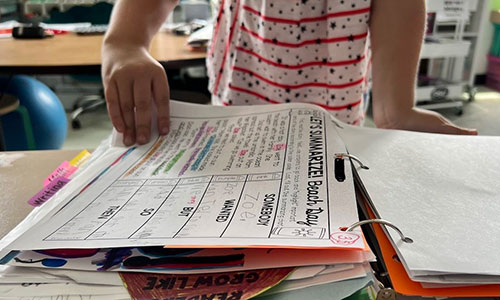
Remember the age-old assignment where teachers ask students to write instructions on how to make a peanut butter and jelly sandwich? It seems like a simple enough task, even if shared orally with students as young as first or second grade. But upon realizing all the steps they inevitably leave out, students often become overwhelmed the next time they’re asked to write instructions, wondering, “What did I leave out? What if I have things in the wrong order?” Thinking about how to kick off your next coaching cycle can feel a little like this: It seems simple enough, but what if a critical step or two are left out in the early stages? Will the coaching cycle recover, or will you be left with a jar of unopened peanut butter sitting on a lone slice of bread? Let’s explore the ways you can find a focus for instructional coaching.
1. Rethink your starting point
The first step in any coaching cycle is usually to choose a goal or focus for instructional coaching, but is this really the first thing coaches and teachers can do together? Much like taking all the necessary ingredients out of the cabinet to make sure you can make that sandwich, coaches and teachers benefit from a thorough needs assessment before entering a coaching cycle. What’s most important for the teacher right now? What will be most effective for their students? These are just two of the many questions coaches can pose to teachers to prepare them for choosing a coaching focus.
Assessing teacher needs can begin during your first 30-minute get-to-know-you meeting, but I encourage you to start even sooner with a digital needs assessment form that you email the teacher. You can keep a bank of questions to pose to teachers or create an online form to share with them a week or two before the coaching cycle begins. Some of the prompts NWEA instructional coaches use are as follows:
- Tell me about your journey to becoming a teacher.
- Tell me about your students. What are their strengths?
- Can you tell me about your previous experiences with coaching or mentoring?
- What do you hope to gain from our work together?
- Can you tell me about your working style?
- What are your hopes for your students and your classroom?
- What data could we use to pre-assess your students to see how they are doing?
2. Encourage prioritization
Teacher needs can be further assessed by asking them to rank the amount of support they’d like with a variety of specific professional learning or student need statements, from “little to no support needed at this time” to “urgent and pressing support needed.” Needs assessment statements can range in topic from things like “collaborating with my teacher team” to “integrating educational technology” to “developing strategies for stress management.”
I encourage you to have a standard list of needs assessment statements to give to the teachers you coach. If there are needs a teacher has but doesn’t see on the list, they can add them to ensure they’re not forgotten when you move on to goal setting and finding a focus for instructional coaching.
3. Use your first meeting to set goals
All coaching sessions need to honor the teacher’s time, as it is the most valuable—yet unrenewable—resource they have. The benefit of having a teacher complete a needs assessment before the first meeting is that your meeting will also need to include discussions of future meeting times, locations, protocols, and the division of work between the coach and teacher. You’ll also then have time to review a teacher’s answers and use your first meeting to focus on the areas requiring the most support.
I encourage you to use a protocol during all meetings to keep sessions on track, and that first goal-setting meeting is no exception. I suggest bringing a printed version of the completed needs assessment to your first meeting with a teacher. One protocol that can help bring clarity to goal selection is to have the teacher circle items they feel are the most pressing for them, underline things that would benefit the students most, and place a star next to the goals that motivate or excite the teacher. By examining the coded list, teachers can see which items meet all three criteria and begin with one of them as their focus for the coaching cycle.
As their coach, you can then help a teacher further refine each goal by asking if it is:
- Clear and simple
- Directly related to learning
- Observable
- Actionable (that is, under the teacher’s control)
- Likely to make a big impact on learning
- Truly meaningful to the teacher and students
- Achievable in the time allotted to the coaching cycle
4. Encourage ownership
After you and the teacher have identified their top goal or goals, you’re ready for the next critical step in finding a focus for instructional coaching: ensuring the teacher feels some ownership over the work you’ll be doing together. This can help increase their engagement during the coaching cycle, and it can also help the coaching cycle be successful.
I suggest asking your teachers to rewrite their goal or goals in their own words. They can do this during your first meeting together, if you’ve allotted enough time, or it can serve as their first “assignment,” to be completed before their next meeting with you.
Set for success
After you’ve had a chance to learn about a teacher’s needs from a coaching cycle and the coaching focus has been selected, refined, and restated by the teacher, planning for the next steps in the coaching cycle can begin. In other words, once your ingredients are all out on the counter and you have a recipe in hand, the sandwich-making can begin.
Spending so much time on goal setting with intentionality is not time wasted but, rather, valuable in helping educators gain clarity on their goals so they can be sure to select a goal that will be the most impactful for their students.
For more information on instructional coaching services through NWEA, visit our website.






